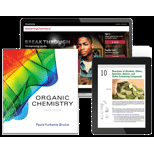
(a)
Interpretation:
- The kinetic and
thermodynamic products of the given reaction has to be predicted.
Concept Introduction:
Reactions of conjugated dienes:
An electrophilic addition reaction to a conjugated diene forms both
Kinetic and thermodynamic products:
Kinetic product: The more rapidly formed product is called the kinetic product. The reactions that produce the kinetic product as the major product are said to be kinetically controlled. The kinetic product predominates when the reaction is irreversible.
Thermodynamic product: The more stable product is called the thermodynamic product. The reactions that produce the thermodynamic product as the major product are said to be thermodynamically controlled. The thermodynamic product predominates when the reaction is reversible. The thermodynamic product is the product with the most highly substituted double bond.
Rule: The stabilities of carbocation are,
(b)
Interpretation:
- The kinetic and thermodynamic products of the given reaction has to be predicted.
Concept Introduction:
Reactions of conjugated dienes:
An electrophilic addition reaction to a conjugated diene forms both
Kinetic and thermodynamic products:
Kinetic product: The more rapidly formed product is called the kinetic product. The reactions that produce the kinetic product as the major product are said to be kinetically controlled. The kinetic product predominates when the reaction is irreversible.
Thermodynamic product: The more stable product is called the thermodynamic product. The reactions that produce the thermodynamic product as the major product are said to be thermodynamically controlled. The thermodynamic product predominates when the reaction is reversible.
Rule: The stabilities of carbocation are,
Want to see the full answer?
Check out a sample textbook solution
Chapter 8 Solutions
Mastering Chemistry with Pearson eText -- Standalone Access Card -- for Organic Chemistry (8th Edition)
- Draw the major product(s) of the reaction of 1-methylcyclohexene with the following reagents, disregarding stereoisomers: 1. NBS/∆/peroxide 2 . Br2/CH2Cl2 3. HBr 4. HBr/peroxideb. For each reaction, show which stereoisomers are obtained.arrow_forwardWhat is the major product of electrophilic addition of HBr to the following alkene? Explain your choice.arrow_forwardWhat is the major product obtained from the reaction of HBr with each of the following?arrow_forward
- a) What product is formed from the [1,7] sigmatropic rearrangement of a deuterium in the following triene? (b) Does this reaction proceed in a suprafacial or antarafacial manner under thermal conditions? (c) Does this reaction proceed in a suprafacial or antarafacial manner under photochemical conditions?arrow_forwardShow how the following starting materials are converted to the given product by a series of two pericyclic reactions. Account for the observed stereochemistry.arrow_forwardIdentify the following pericyclic reaction; explain the course, product distribution and stereochemistry of the reaction. Where the first product is produced 70% and the second product is produced 30%.arrow_forward
- Which statement best describes the stereochemistry of the product?arrow_forwarda. Draw the major product(s) of the reaction of 1-methylcyclohexene with the following reagents, disregarding stereoisomers: 1. NBS/Δ/peroxide 2. Br2/CH2Cl2 3. HBr 4. HBr/peroxide b. For each reaction, show which stereoisomers are obtained.arrow_forwardConsider a reaction where cis-but-2-ene is treated with OsO4 followed by NaHSO3/H2O. Draw the structure of one product that is formed in the reaction, including correct stereochemistry.arrow_forward
- For each one of the following reactions, show step by step mechanism of the reactions and indicate the stereochemistry of the products and their relationshiparrow_forwardwhat are the products? please indicate the relative stereochemistry for the following transformations and indicate the major product.arrow_forwardWrite down the major products or the other reactants and or the reaction conditions for the following reactions showing stereochemistry whenever appropriatearrow_forward
 ChemistryChemistryISBN:9781305957404Author:Steven S. Zumdahl, Susan A. Zumdahl, Donald J. DeCostePublisher:Cengage Learning
ChemistryChemistryISBN:9781305957404Author:Steven S. Zumdahl, Susan A. Zumdahl, Donald J. DeCostePublisher:Cengage Learning ChemistryChemistryISBN:9781259911156Author:Raymond Chang Dr., Jason Overby ProfessorPublisher:McGraw-Hill Education
ChemistryChemistryISBN:9781259911156Author:Raymond Chang Dr., Jason Overby ProfessorPublisher:McGraw-Hill Education Principles of Instrumental AnalysisChemistryISBN:9781305577213Author:Douglas A. Skoog, F. James Holler, Stanley R. CrouchPublisher:Cengage Learning
Principles of Instrumental AnalysisChemistryISBN:9781305577213Author:Douglas A. Skoog, F. James Holler, Stanley R. CrouchPublisher:Cengage Learning Organic ChemistryChemistryISBN:9780078021558Author:Janice Gorzynski Smith Dr.Publisher:McGraw-Hill Education
Organic ChemistryChemistryISBN:9780078021558Author:Janice Gorzynski Smith Dr.Publisher:McGraw-Hill Education Chemistry: Principles and ReactionsChemistryISBN:9781305079373Author:William L. Masterton, Cecile N. HurleyPublisher:Cengage Learning
Chemistry: Principles and ReactionsChemistryISBN:9781305079373Author:William L. Masterton, Cecile N. HurleyPublisher:Cengage Learning Elementary Principles of Chemical Processes, Bind...ChemistryISBN:9781118431221Author:Richard M. Felder, Ronald W. Rousseau, Lisa G. BullardPublisher:WILEY
Elementary Principles of Chemical Processes, Bind...ChemistryISBN:9781118431221Author:Richard M. Felder, Ronald W. Rousseau, Lisa G. BullardPublisher:WILEY





